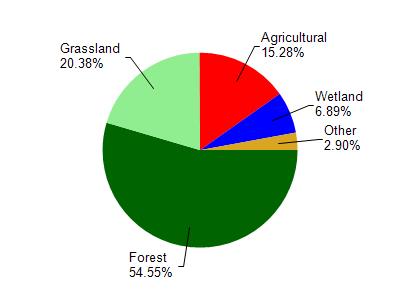
2.35 Miles
0 - 2.35
Cool-Cold Headwater, Coldwater
2015
Good
Dane
Yes
No
No
Fish and Aquatic Life
Overview
Moen Creek is a spring fed tributary to Elvers Creek. The headwaters of Moen Creek begin near Mount Horeb and have been impounded to form Stewart Lake. Moen Creek is considered a Class II trout stream although the creek has the potential to support a Class I fishery if properly managed. A cursory habitat evaluation was completed in the summer of 2001. The evaluation found the creek to have fair to good in-stream habitat. The creek has good bottom substrate and good riffles and runs in some areas, but not in others. This may be attributed to the moderate nonpoint source pollution making its way to the creek from the surrounding watershed. The creek also experiences streambank erosion due to unstable banks in some areas.
Stewart Lake causes some use problems in the headwater area. The creek just below the impoundment has filamentous algae, a sign of a high nutrient load. In addition, monitoring conducted in the summer of 2001 found that the section of the creek just below the lake had lower dissolved oxygen and higher temperatures in the early morning than other locations in the creek. The creek also receives stormwater runoff from Mount Horeb. Stewart Lake County Park provides public access to the headwaters of the creek.
Date 2002
Author Aquatic Biologist
Condition
Wisconsin has over 84,000 miles of streams, 15,000 lakes and milllions of acres of wetlands. Assessing the condition of this vast amount of water is challenging. The state's water monitoring program uses a media-based, cross-program approach to analyze water condition. An updated monitoring strategy (2015-2020) is now available. Compliance with Clean Water Act fishable, swimmable standards are located in the Executive Summary of Water Condition in 2018. See also the 'monitoring and projects' tab.
Reports
Management Goals
Wisconsin's Water Quality Standards provide qualitative and quantitative goals for waters that are protective of Fishable, Swimmable conditions [Learn more]. Waters that do not meet water quality standards are considered impaired and restoration actions are planned and carried out until the water is once again fishable and swimmable
Management goals can include creation or implementation of a Total Maximum Daily Load analysis, a Nine Key Element Plan, or other restoration work, education and outreach and more. If specific recommendations exist for this water, they will be displayed below online.
Monitoring
Monitoring the condition of a river, stream, or lake includes gathering physical, chemical, biological, and habitat data. Comprehensive studies often gather all these parameters in great detail, while lighter assessment events will involve sampling physical, chemical and biological data such as macroinvertebrates. Aquatic macroinvertebrates and fish communities integrate watershed or catchment condition, providing great insight into overall ecosystem health. Chemical and habitat parameters tell researchers more about human induced problems including contaminated runoff, point source dischargers, or habitat issues that foster or limit the potential of aquatic communities to thrive in a given area. Wisconsin's Water Monitoring Strategy was recenty updated.
Grants and Management Projects
Monitoring Projects
| WBIC | Official Waterbody Name | Station ID | Station Name | Earliest Fieldwork Date | Latest Fieldwork Date | View Station | View Data |
|---|
| 1252100 | Moen Creek | 10037660 | MOEN CREEK (USGS 05406345) SITE P AT MOUNT HOREB | 3/24/1993 | 9/13/1993 | Map | Data |
| 1252300 | Stewart Lake | 10001220 | Stewart Lake | 7/27/1999 | 6/23/2015 | Map | Data |
| 1252100 | Moen Creek | 10001220 | Stewart Lake | 7/27/1999 | 6/23/2015 | Map | Data |
| 5036242 | Unnamed | 10001220 | Stewart Lake | 7/27/1999 | 6/23/2015 | Map | Data |
| 1252100 | Moen Creek | 10037654 | Moen Creek (USGS 05406346 SITE O) at pump station | 11/20/1992 | 11/20/1992 | Map | Data |
| 1252100 | Moen Creek | 10009623 | Moen Creek At Hwy Jg Bridge (Sec34) | 1/1/2015 | 1/1/2015 | Map | Data |
| 1252100 | Moen Creek | 133489 | Moen Creek at Bergum Rd | 5/24/2001 | 10/16/2001 | Map | Data |
|

Watershed Characteristics
Moen Creek is located in the Mill and Blue Mounds Creek watershed which is 186.74 mi². Land use in the watershed is primarily forest (54.60%), grassland (20.40%) and a mix of agricultural (15.30%) and other uses (9.80%). This watershed has 382.87 stream miles, 106.91 lake acres and 6,596.99 wetland acres.
Nonpoint Source Characteristics
This watershed is ranked Medium for runoff impacts on streams, Low for runoff impacts on lakes and High for runoff impacts on groundwater and therefore has an overall rank of High. This value can be used in ranking the watershed or individual waterbodies for grant funding under state and county programs.However, all waters are affected by diffuse pollutant sources regardless of initial water quality. Applications for specific runoff projects under state or county grant programs may be pursued. For more information, go to surface water program grants.
Moen Creek is considered a Cool-Cold Headwater, Coldwater under the state's Natural Community Determinations.
Natural communities (stream and lake natural communities) represent model results and DNR staff valiation processes that confirm or update predicted conditions based on flow and temperature modeling from historic and current landscape features and related variables. Predicated flow and temperatures for waters are associated predicated fish assemblages (communities). Biologists evaluate the model results against current survey data to determine if the modeled results are corect and whether biological indicators show water quaity degradation. This analysis is a core component of the state's resource management framework. Wisconsin's Riverine Natural Communities.
Cool (Cold-Transition) Headwaters are small, usually perennial streams with cold to cool summer temperatures. Coldwater fishes are common to uncommon (<10 per 100 m), transitional fishes are abundant to common, and warm water fishes are uncommon to absent. Headwater species are abundant to common, mainstem species are common to absent, and river species are absent.